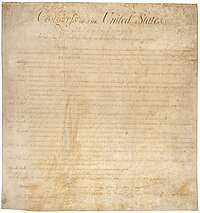4. poprawka do Konstytucji Stanów Zjednoczonych
4. poprawka do Konstytucji Stanów Zjednoczonych – uchwalona w ramach Karty Praw Stanów Zjednoczonych Ameryki (pierwsze dziesięć poprawek do Konstytucji Stanów Zjednoczonych), weszła w życie 15 grudnia 1791 roku[1][2].
Treść
Treść oryginalna:
Amendment IV
The right of the people to be secure in their persons, houses, papers, and effects, against unreasonable searches and seizures, shall not be violated, and no Warrants shall issue, but upon probable cause, supported by Oath or affirmation, and particularly describing the place to be searched, and the persons or things to be seized.
co można przetłumaczyć jako[1]:
Poprawka IV
Prawa ludu do nietykalności osobistej, mieszkania, dokumentów i mienia nie wolno naruszać przez nieuzasadnione rewizje i zatrzymanie; nakaz w tym przedmiocie można wystawić tylko wówczas, gdy zachodzi wiarygodna przyczyna potwierdzona przysięgą lub zastępującym ją oświadczeniem. Miejsce podlegające rewizji oraz osoby i rzeczy podlegające zatrzymaniu powinny być w nakazie szczegółowo określone.
Przypisy
- ↑ a b Andrzej Pułło: Konstytucja Stanów Zjednoczonych Ameryki. Warszawa: Wydawnictwo Sejmowe, 2002.
- ↑ The New United States of America Adopted the Bill of Rights December 15, 1791 (ang.). Biblioteka Kongresu. [dostęp 2015-11-07].
| ||||||||||||
Media użyte na tej stronie
The Bill of Rights, twelve articles of amendment to the to the United States Constitution proposed in 1789, ten of which, Articles three through twelve, became part of the United States Constitution in 1791. Note that the First Amendment is actually "Article the third" on the document, Second Amendment is "Article the fourth", and so on. "Article the second" is now the 27th Amendment. "Article the first" has not been ratified.

